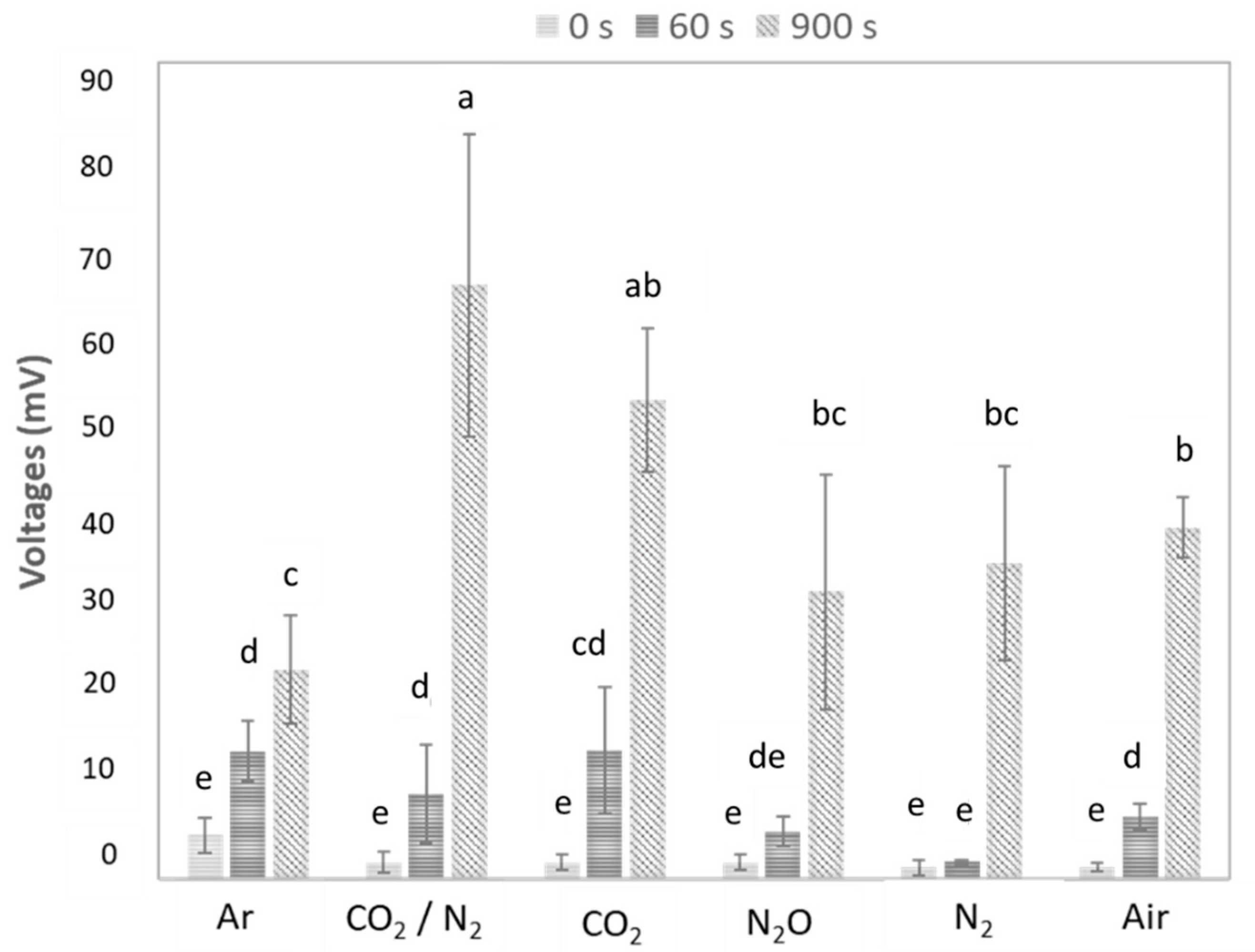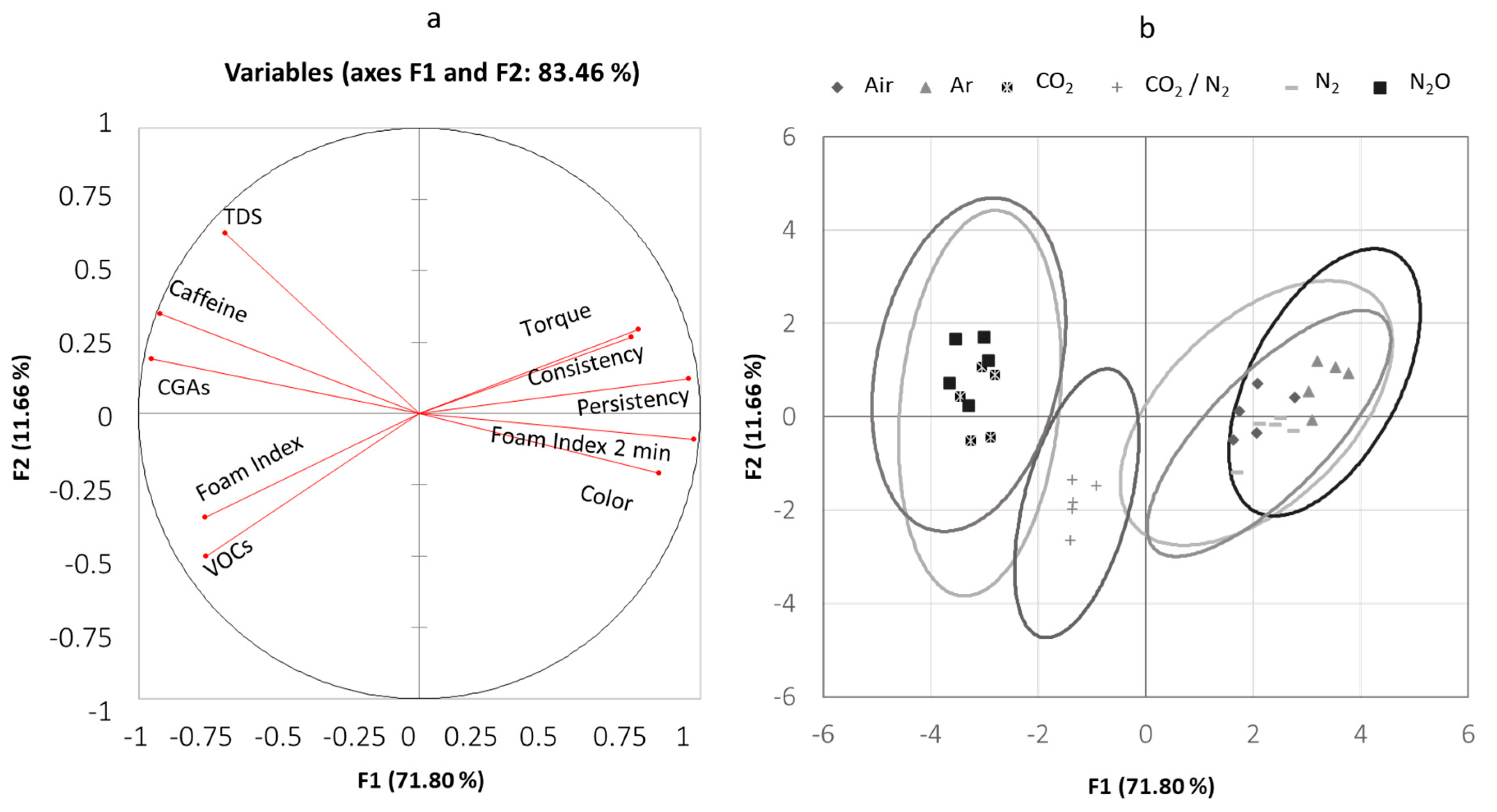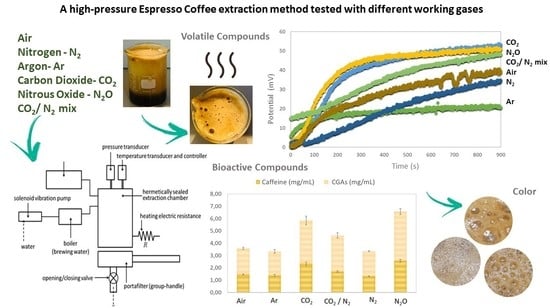Physical and Chemical Effects of Different Working Gases in Coffee Brewing: A Case Study of Caffè Firenze
Abstract
1. Introduction
2. Materials and Methods
2.1. Experimental Design
2.2. Coffee Samples and the Caffè Firenze Extraction Device
- −
- A sealed extraction chamber where coffee extraction takes place under high pressure (15 bar) and at a controlled temperature (80 °C).
- −
- A system to feed pressurized gas into the extraction chamber.
- −
- An electric pump to feed pressurized water (up to 20 bar) into the extraction chamber.
- −
- An electric boiler to heat the water used for brewing.
- −
- An electric resistance to heat the extraction chamber.
- −
- A portafilter where the ground coffee is tamped; was equipped with a manual valve to allow the extraction chamber to be closed.
- −
- Pressure and temperature transducers inside the extraction chamber.
2.3. Selection of Food-Grade Gases
2.4. Foam Index Persistence and Consistency
2.5. Rheological Measurements
- -
- The rotational speed of the cylinder: 300 rpm.
- -
- The data acquisition time: 60 s.
2.6. Color
2.7. Volatile Organic Compounds
2.8. Total Dissolved Solids, Caffeine and Chlorogenic Acids
2.9. Statistical Analyses
3. Results and Discussion
3.1. Foam Structure
3.2. Analysis of Components in Solution
3.3. Correlations between Parameters and Samples
4. Conclusions
Author Contributions
Funding
Acknowledgments
Conflicts of Interest
References
- Angeloni, G.; Guerrini, L.; Masella, P.; Bellumori, M.; Daluiso, S.; Parenti, A.; Innocenti, M. What kind of coffee do you drink? An investigation on effects of eight different extraction methods. Food Res. Int. 2019, 116. [Google Scholar] [CrossRef]
- Parenti, A.; Guerrini, L.; Masella, P.; Spinelli, S.; Calamai, L.; Spugnoli, P. Comparison of espresso coffee brewing techniques. J. Food Eng. 2014, 121, 112–117. [Google Scholar] [CrossRef]
- Folmer, B.; Blank, I.; Hofmann, T. Crema—Formation, Stabilization, and Sensation. Cr. Sci. Coffee 2017, 399–417. [Google Scholar] [CrossRef]
- Navarini, L.; Ferrari, M.; Liverani, F.S.; Liggieri, L.; Ravera, F. Dynamic tensiometric characterization of espresso coffee beverage. Food Hydrocoll. 2004, 18, 387–393. [Google Scholar] [CrossRef]
- Dold, S.; Lindinger, C.; Kolodziejczyk, E.; Pollien, P.; Ali, S.; Germain, J.C.; Perin, S.G.; Pineau, N.; Folmer, B.; Engel, K.H.; et al. Influence of foam structure on the release kinetics of volatiles from espresso coffee prior to consumption. J. Agric. Food Chem. 2011, 59, 11196–11203. [Google Scholar] [CrossRef] [PubMed]
- Piazza, L.; Gigli, J.; Bulbarello, A. Interfacial rheology study of espresso coffee foam structure and properties. J. Food Eng. 2008. [Google Scholar] [CrossRef]
- Illy, A.; Viani, R. Espresso Coffee: The Chemistry of Quality; Academic Press: London, UK, 1995. [Google Scholar]
- Illy, E.; Navarini, L. Neglected Food Bubbles: The Espresso Coffee Foam. Food Biophys. 2011, 6, 335–348. [Google Scholar] [CrossRef] [PubMed]
- Masella, P.; Guerrini, L.; Spinelli, S.; Calamai, L.; Spugnoli, P.; Illy, F.; Parenti, A. A new espresso brewing method. J. Food Eng. 2015, 146, 204–208. [Google Scholar] [CrossRef]
- Andueza, S.; Maeztu, L.; Dean, B.; De Peña, M.P.; Bello, J.; Cid, C. Influence of water pressure on the final quality of arabica espresso coffee. Application of multivariate analysis. J. Agric. Food Chem. 2002, 50, 7426–7431. [Google Scholar] [CrossRef]
- Getachew, A.T.; Chun, B.S. Influence of hydrothermal process on bioactive compounds extraction from green coffee bean. Innov. Food Sci. Emerg. Technol. 2016, 38, 24–31. [Google Scholar] [CrossRef]
- Angeloni, G.; Masella, P.; Guerrini, L.; Innocenti, M.; Bellumori, M.; Parenti, A. Application of a screening design to recover phytochemicals from spent coffee grounds. Food Bioprod. Process. 2019, 118. [Google Scholar] [CrossRef]
- Laganà, P.; Coniglio, G.; Patanè, P.; Assunta Cava, M.; Parisi, S.; Gambuzza, M.E.; Delia, S.; Coniglio, M.A. Chemistry and Hygiene of Food Gases; Springer: Berlin/Heidelberg, Germany, 2019; ISBN 9783030352271. [Google Scholar]
- Cowart, B.J. I/® The Addition of CO2 to Traditional Taste Solutions Alters Taste Quality. Chem. Senses 1998, 23, 397–402. [Google Scholar] [CrossRef] [PubMed][Green Version]
- Dessirier, J.; Simons, C.T.; Mahony, M.O.; Carstens, E. The Oral Sensation of Carbonated Water: Cross-desensitization by Capsaicin and Potentiation by Amiloride. Chem. Senses 2001, 26, 639–643. [Google Scholar] [CrossRef] [PubMed]
- Mannheim, C.H.; Soffer, T. Shelf-life extension of cottage cheese by modified atmosphere packaging. LWT Food Sci. Tech. 1996, 29, 767–771. [Google Scholar] [CrossRef]
- Yokozeki, A.; Shiflett, M.B. The solubility of CO2 and N2O in olive oil. Fluid Phase Equilibria. 2001, 305, 127–131. [Google Scholar] [CrossRef]
- Adhikari, B.M.; Truong, T.; Bansal, N.; Bhandari, B. Use of Gases in Dairy Manufacturing: A Review. Crit. Rev. Food Sci. Nutr. 2017, 8398. [Google Scholar] [CrossRef]
- Petracco, M. The cup. In Espresso Coffee: The Science of Quality; Academic Press: London, UK, 2005; pp. 290–315. [Google Scholar]
- Severini, C.; Romani, S.; Pinnavaia, G.G. Investigation into the quality of espresso coffee. Ind. Aliment. 1997, 36, 12–16. [Google Scholar]
- Angeloni, G.; Guerrini, L.; Masella, P.; Innocenti, M.; Bellumori, M.; Parenti, A. Characterization and comparison of cold brew and cold drip coffee extraction methods. J. Sci. Food Agric. 2019, 99. [Google Scholar] [CrossRef]
- Nunes, F.M.; Coimbra, M.A.; Duarte, A.C.; Delgadillo, I. Foamability, Foam Stability, and Chemical Composition of Espresso Coffee as Affected by the Degree of Roast. J. Agric. Food Chem. 1997, 45, 3238–3243. [Google Scholar] [CrossRef]
- Gloess, A.N.; Schönbächler, B.; Klopprogge, B.; D’Ambrosio, L.; Chatelain, K.; Bongartz, A.; Strittmatter, A.; Rast, M.; Yeretzian, C. Comparison of nine common coffee extraction methods: Instrumental and sensory analysis. Eur. Food Res. Technol. 2013, 236, 607–627. [Google Scholar] [CrossRef]
- Saint-Jalmes, A. Physical chemistry in foam drainage and coarsening. Soft Matter 2006, 2, 836–849. [Google Scholar] [CrossRef] [PubMed]
- Gevantman, L.H. Solubility of Selected Gases in Water. In Proceedings of the CRC Handbook of Chemistry and Physics, 91th ed.; CRC Press: Boca Raton, FL, USA, 2000; pp. 80–83. [Google Scholar]
- Caporaso, N.; Genovese, A.; Canela, M.D.; Civitella, A.; Sacchi, R. Neapolitan coffee brew chemical analysis in comparison to espresso, moka and American brews. Food Res. Int. 2014, 61, 152–160. [Google Scholar] [CrossRef]
- Prankerd, R.J. Critical compilation of pKa values for pharmaceutical substances. In Profiles of Drug Substances, Excipients and Related Methodology; Elsevier: Amsterdam, The Netherlands, 2007; Volume 33, pp. 1–33. [Google Scholar]
- Fujioka, K.; Shibamoto, T. Chlorogenic acid and caffeine contents in various commercial brewed coffees. Food Chem. 2008, 106, 217–221. [Google Scholar] [CrossRef]




| Gas | Air | Ar | CO2 | CO2/N2 | N2 | N2O |
|---|---|---|---|---|---|---|
| Foam Persistence (min) | >480 | >480 | <2 | 15–18 | >480 | <2 |
| Foam Index (%) after 30 s | 60.40 | 50.20 | 76.10 | 88.80 | 40.20 | 78.80 |
| 15.44 | 1.10 | 11.57 | 6.42 | 13.39 | 6.43 | |
| b | c | ab | a | c | ab | |
| Foam Index (%) after 2 m | 32.20 | 34.00 | Nd | 13.30 | 28.20 | Nd |
| 1.48 | 1.58 | 1.86 | 1.64 | |||
| ab | a | d | c | b | d | |
| Foam Consistency (s) | 22.42 | 23.28 | 2.45 | 2.72 | 6.71 | 2.64 |
| 6.71 | 5.08 | 0.21 | 0.38 | 0.67 | 0.09 | |
| a | a | c | c | b | c | |
| Torque (N m) | 0.08 | 0.21 | 0.02 | 0.05 | 0.08 | 0.04 |
| 0.03 | 0.05 | 0.00 | 0.03 | 0.01 | 0.02 | |
| b | a | c | bc | b | bc | |
| VOCs (mV) | 28.00 | 17.30 | 43.32 | 48.77 | 20.60 | 36.79 |
| 3.15 | 3.08 | 7.21 | 10.02 | 4.10 | 9.21 | |
| bc | c | a | a | c | ab |
| GAS | Air | Ar | CO2 | CO2/N2 | N2 | N2O |
|---|---|---|---|---|---|---|
| TDS (%) | 3.36 | 2.98 | 4.21 | 2.77 | 2.62 | 4.76 |
| 0.31 | 0.15 | 0.60 | 0.36 | 0.26 | 0.43 | |
| b | b | a | b | b | a | |
| Caffeine (mg/mL) | 1.46 | 1.37 | 2.33 | 1.69 | 1.32 | 2.57 |
| 0.04 | 0.09 | 0.13 | 0.07 | 0.03 | 0.11 | |
| c | c | a | b | c | a | |
| CGAs (mg/mL) | 2.12 | 1.95 | 3.51 | 2.94 | 2.03 | 3.99 |
| 0.11 | 0.15 | 0.35 | 0.21 | 0.04 | 0.24 | |
| c | c | a | b | c | a |
Publisher’s Note: MDPI stays neutral with regard to jurisdictional claims in published maps and institutional affiliations. |
© 2020 by the authors. Licensee MDPI, Basel, Switzerland. This article is an open access article distributed under the terms and conditions of the Creative Commons Attribution (CC BY) license (http://creativecommons.org/licenses/by/4.0/).
Share and Cite
Angeloni, G.; Masella, P.; Guerrini, L.; Spadi, A.; Bellumori, M.; Innocenti, M.; Parenti, A. Physical and Chemical Effects of Different Working Gases in Coffee Brewing: A Case Study of Caffè Firenze. Foods 2020, 9, 1825. https://doi.org/10.3390/foods9121825
Angeloni G, Masella P, Guerrini L, Spadi A, Bellumori M, Innocenti M, Parenti A. Physical and Chemical Effects of Different Working Gases in Coffee Brewing: A Case Study of Caffè Firenze. Foods. 2020; 9(12):1825. https://doi.org/10.3390/foods9121825
Chicago/Turabian StyleAngeloni, Giulia, Piernicola Masella, Lorenzo Guerrini, Agnese Spadi, Maria Bellumori, Marzia Innocenti, and Alessandro Parenti. 2020. "Physical and Chemical Effects of Different Working Gases in Coffee Brewing: A Case Study of Caffè Firenze" Foods 9, no. 12: 1825. https://doi.org/10.3390/foods9121825
APA StyleAngeloni, G., Masella, P., Guerrini, L., Spadi, A., Bellumori, M., Innocenti, M., & Parenti, A. (2020). Physical and Chemical Effects of Different Working Gases in Coffee Brewing: A Case Study of Caffè Firenze. Foods, 9(12), 1825. https://doi.org/10.3390/foods9121825









